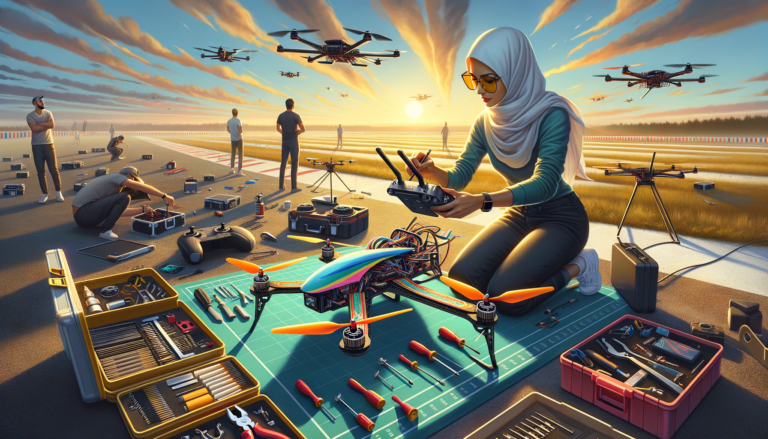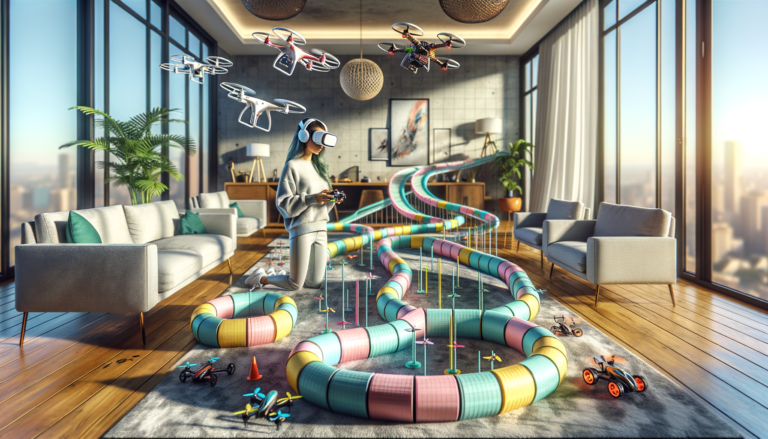Buckle up, future drone racers! 
Understanding DIY Racing Drones
Let’s dive into the world of DIY racing drones. You might be wondering, “What exactly are these DIY racing drones?” Well, imagine a high-speed, agile flying machine that you’ve built with your own hands. That’s the essence of a DIY racing drone.
To build one, you’ll need a variety of components. It’s like putting together a high-tech puzzle. You’ll need a frame, motors, propellers, a flight controller, ESCs (Electronic Speed Controllers), a radio receiver, and a battery. Don’t forget the FPV (First Person View) system if you want that immersive racing experience!
Now, you might be thinking, “Do I need to be an engineer to build one?” Not necessarily, but it does require some skills. You’ll need to be comfortable with basic electronics, soldering, and a bit of programming. It’s not rocket science, but it’s not exactly a walk in the park either.
One of the coolest things about DIY drones is the customization options. Want a faster drone? Swap out the motors. Need longer flight times? Change the battery. The sky’s the limit when it comes to tweaking your build.
Of course, we can’t ignore the cost factor. Building your own drone can be more cost-effective in the long run, especially if you enjoy upgrading and modifying. However, the initial investment can be higher than buying a ready-to-fly drone, so keep that in mind.
Exploring Ready-to-Fly (RTF) Racing Drones
Now, let’s shift gears and talk about Ready-to-Fly (RTF) racing drones. As the name suggests, these babies are ready to take to the skies right out of the box. No assembly required!
There are quite a few popular models out there. Brands like DJI, EMAX, and ImmersionRC offer some impressive RTF racing drones. These come with everything you need to start flying immediately.
One of the biggest advantages of RTF drones is their ease of use. You don’t need to worry about compatibility issues or complex setup processes. Just charge the battery, bind your controller, and you’re good to go!
But don’t think RTF drones are toys. Many of these machines pack some serious performance capabilities. They can reach high speeds and perform acrobatic maneuvers that’ll make your head spin.
Price-wise, RTF drones can range from budget-friendly options to high-end models. While they might seem more expensive upfront compared to DIY builds, remember that you’re paying for convenience and immediate usability.
Pros and Cons of DIY Racing Drones
Building your own drone comes with its fair share of advantages. For one, you gain an intimate understanding of how your drone works. This knowledge is invaluable when it comes to repairs and upgrades.
However, it’s not all smooth sailing. There can be challenges, like compatibility issues between components or the frustration of troubleshooting when things don’t work as expected.
The learning curve can be steep, and it does require a significant time investment. But many enthusiasts find this process rewarding in itself. It’s like learning a new language – challenging but ultimately fulfilling.
In the long run, the knowledge you gain from building your own drone can be incredibly beneficial. You’ll be able to diagnose issues quickly and keep your drone in top shape.
Plus, there’s a fantastic community of DIY drone builders out there. They’re always ready to offer advice, share tips, and help you overcome obstacles. It’s like joining a global club of tech-savvy aviation enthusiasts!
Pros and Cons of RTF Racing Drones
Ready-to-Fly drones have their own set of benefits. The most obvious one is convenience. You can literally go from unboxing to flying in a matter of minutes.
However, this convenience comes at a cost. RTF drones typically offer less flexibility when it comes to upgrades and modifications. You’re somewhat locked into the manufacturer’s ecosystem.
That said, the out-of-the-box performance of many RTF drones is impressive. They’re often tuned by experts to deliver optimal performance without any tweaking on your part.
While upgrades might be limited, some RTF drones do offer modification possibilities. It’s just not as extensive as what you’d get with a DIY build.
Another advantage of RTF drones is manufacturer support and warranties. If something goes wrong, you have a company to turn to for repairs or replacements.
Skill Development: DIY vs RTF
When it comes to skill development, DIY and RTF drones offer different paths. Building your own drone hones your technical skills. You’ll learn about electronics, gain soldering experience, and maybe even dabble in some coding.
RTF drones, on the other hand, allow you to focus purely on developing your piloting skills. You can spend all your time practicing maneuvers and racing techniques instead of tinkering with hardware.
When it comes to troubleshooting and maintenance, DIY builders definitely have an edge. They know their drones inside and out. RTF users might need to rely more on manufacturer support or online tutorials.
Both paths have plenty of learning resources available. YouTube tutorials, online forums, and local drone clubs are great for both DIY builders and RTF pilots.
Interestingly, both paths can lead to career opportunities in drone racing and building. Whether you’re a skilled builder or an expert pilot, there’s a place for you in the growing drone industry.
Cost Analysis: DIY vs RTF Racing Drones
Let’s talk money. The initial investment for a DIY build can be higher, especially if you’re starting from scratch and need to buy tools. RTF drones often have a lower entry point.
However, in the long run, DIY builds can be more cost-effective. Upgrades and repairs are usually cheaper when you can do them yourself.
When it comes to value retention, it’s a bit of a toss-up. A well-maintained RTF drone from a reputable brand might hold its value better. But a custom DIY build with high-end components could also fetch a good price in the second-hand market.
For those on a tight budget, both paths offer options. You can start with a basic DIY build and upgrade over time, or opt for an entry-level RTF drone.
Don’t forget about hidden costs. For DIY builds, factor in tools and potential replacement parts due to building errors. For RTF drones, consider the cost of proprietary replacement parts or potential shipping costs for repairs.
Making the Right Choice for Beginners
So, you’re a beginner trying to decide between DIY and RTF. First, assess your technical skills and interests. Do you enjoy tinkering with electronics? Or would you rather focus solely on flying?
Next, consider your time commitment. Building a drone takes time. Are you willing to invest that time, or do you want to start flying right away?
Your budget is another crucial factor. Remember, DIY might cost more upfront but could save money in the long run. RTF drones offer a clearer picture of your total cost from the get-go.
Think about your short-term and long-term goals. Do you want to learn about drone technology, or is your primary interest in becoming a skilled pilot?
Lastly, don’t hesitate to seek advice from experienced racers. They’ve been in your shoes and can offer valuable insights. Join online forums or local drone clubs to get personalized advice.
Remember, there’s no one-size-fits-all answer. The best choice depends on your individual circumstances and goals. Whichever path you choose, welcome to the exciting world of drone racing!
Conclusion
Whew! We’ve zoomed through the ins and outs of DIY and RTF racing drones, and now it’s time for you to make your choice. Remember, there’s no one-size-fits-all answer – it’s all about what revs your engines! 









 Did you know that the global e-learning…
Did you know that the global e-learning…